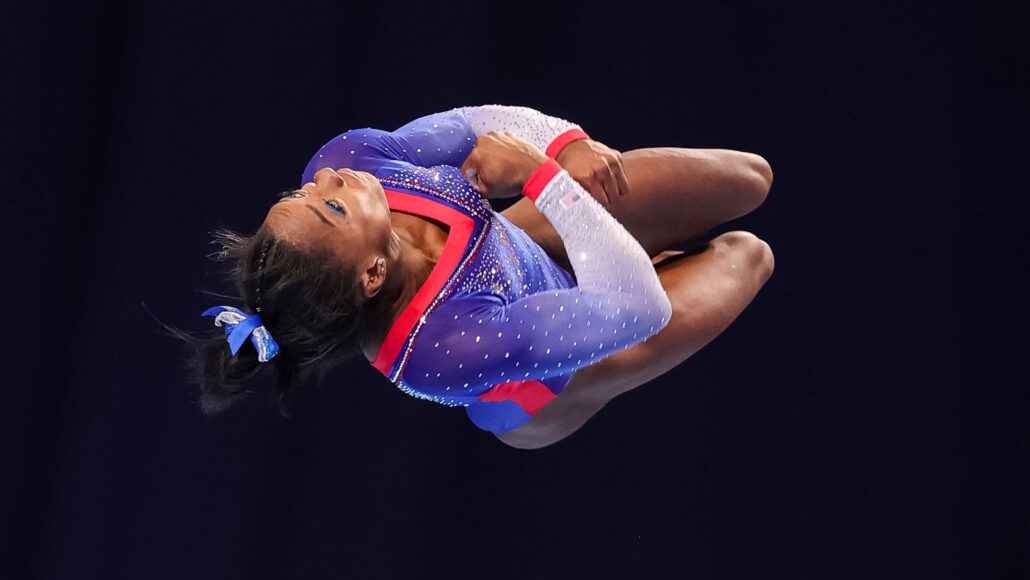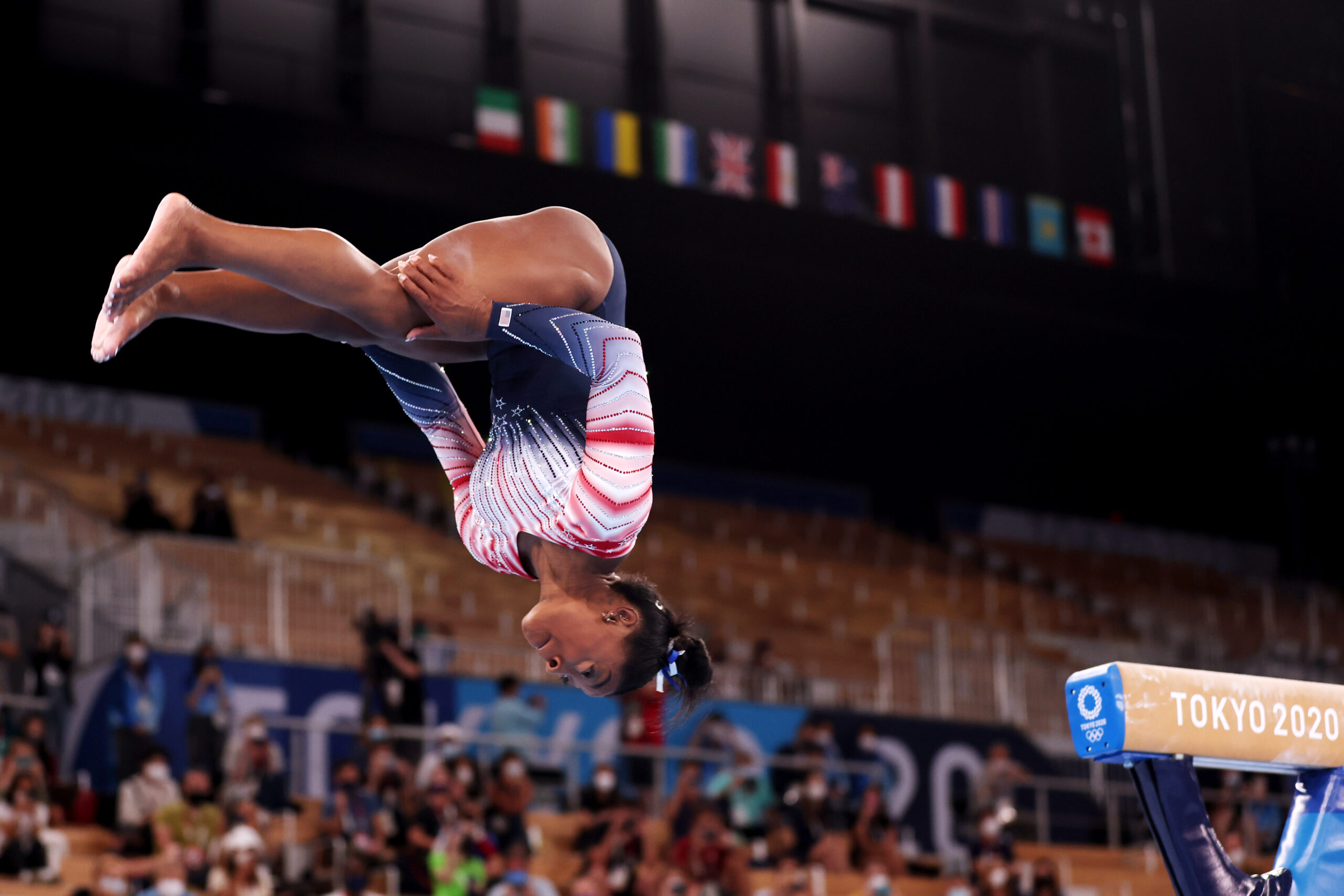What happened when Simone Biles got the twisties at the Olympics?
A sudden mental block for completing a twisting flip is disorienting and can be dangerous

Gymnast Simone Biles (pictured) did twisting rotations, flips and other amazing moves at the June 2021 U.S. Olympic trials in St. Louis, Mo. Then she got the twisties at the Olympics in Tokyo, Japan. As a result, she pulled out of several events.
Carmen Mandato/Getty Images Sport
Simone Biles has been called the greatest gymnast of all time. But something went very wrong during one of her routines at the Olympics in Tokyo, Japan this summer. Biles sprinted down the mat and flipped into the air, hitting the vault table hands down. When she pushed off from it, she meant to rotate two-and-a-half times. Instead, she made only one-and-a-half rotations. And she landed awkwardly.
The problem was “a little bit of the twisties,” Biles later told reporters. She felt “a little bit lost in the air.”
The twisties is how athletes describe a mental block that can mess with a sense of where their body is in space. “Suddenly, you’re not able to do this movement that you were able to do,” says Gregory Youdan. “You’re in the air, and you’re like, ‘I don’t know how to get down.’” Youdan studies the science of movement and motor control at Dance/NYC in New York City. The group supports dancers in that region with research and advocacy.
Problems similar to the twisties happen in other sports, Youdan notes. Golfers with the “yips” can’t follow through on swings, for example. And dancers can get disoriented. But the twisties can be especially dangerous, he says. “Flying through the air is a much bigger risk to the athlete than losing your orientation during a dance turn.”
No one can predict just who will get the twisties or when. Nor can they say how long it will take to recover. But scientists know a lot about parts of the brain that let athletes do complex skills and sense where their bodies are. So they have some ideas about what might trigger the twisties.
Getting in a twist
One factor that could trigger the twisties is a change in an athlete’s environment, Youdan says. In Biles’ case, because of the COVID-19 pandemic, gymnasts at the Olympics did not have an audience in the stands. So the sights and sounds were different from what athletes were used to at major competitions.
Stress may also play a role, Youdan says. In a video made after the Olympics, Biles said she had felt stressed even before Tokyo. “It kind of built up over time,” she said, “and my body and my mind just said no.”
But what actually happens to the brain when a gymnast gets the twisties?
One possibility is that different parts of the brain don’t work with each other the way they should. The brain uses multiple cues to keep us in balance as we move, explains Kathleen Cullen. She’s a biomedical engineer at Johns Hopkins University in Baltimore, Md. We get some clues from our sense of vision. Additionally, five structures in our inner ears report to the brain about how our heads are rotating and moving forward or back and from side to side. Sensors in the rest of our bodies tell how our muscles have flexed. The brain puts all those data together to inform our bodies of where they are in space.

As an athlete practices a skill, “the brain builds an internal model of the sensory input it expects, based on its experience,” Cullen says. When the athlete performs that move again later, the brain compares its model to the sensory input it’s now getting. The brain can then tell the body what necessary corrections it may need to make.
Our brains do all this unconsciously, in thousandths of a second. It happens in the cerebellum (Sehr-eh-BELL-um). This part of the brain is shaped a bit like a cauliflower and sits on top of the brain stem at the back of the head.
Meanwhile, conscious parts of an athlete’s brain also are active. The prefrontal cortex, at the front of the head, is active in planning and visual perception. And an area in the center of the brain, the ventral striatum (VEN-trul Stry-AY-tum), plays a role in motivation. “If the stakes are not too high, but they’re high enough to activate these areas, it can make you pay attention and focus,” Cullen says. Ideally, the conscious areas should work efficiently with the background autopilot functions to let an athlete perform skills well.
Too much activation, however, can cause problems. People may choke or freeze up. They may start overthinking things. Or, they may get distracted or disoriented. Any of that might mess with the brain’s ability to complete a routine as planned.
Exactly how that confusion happens in the brain happens is still a mystery. For now, scientists can’t track what happens inside the brain in real time as the twisties happen. Researchers have used videos, small sensors, equations and computer models to study what athletes do when they flip and rotate. Still, Youdan says, “you can’t have somebody do flips in an MRI machine to see what their brain waves are doing.” There are wearable brain scanners. But these are still too big to wear without potentially affecting an athlete’s performance.
Back to the mat
After her twisties incident, Biles pulled out of several events at the Olympics. But only a couple of weeks later, she was again executing twisting rotations. She started by practicing on a trampoline. “It was literally like second nature again,” she told People magazine.
For some people, however, overcoming the twisties, yips or similar problems calls for a longer period of retraining, says Youdan. They go back to basics and learn the skill again. He says scientists aren’t sure why the process goes quickly for some people and takes longer for others.
It’s also unclear what techniques athletes might use to prevent the twisties, Cullen says. Mental rehearsal can help athletes get into the right frame of mind. This involves imagining themselves going through their moves. Deep controlled breathing also can help rein in stress that might mess with someone’s performance. But further research is needed to figure out what might work best.
Biles begins touring with other gymnasts again on September 21. And she said earlier this month that she “wouldn’t change anything for the world” about her Olympic experience in Tokyo. That experience taught her — and others — about the importance of stepping back when we need to. “Mental health comes first,” Biles tweeted on August 18. “That’s more important than any other medal you could win.”







